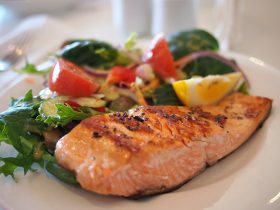Let’s face it: sometimes we lack the time, energy, or culinary inspiration to enjoy dealing with food. When that’s the case, meals and snacks can become haphazard, unsatisfying, and a source of significant frustration—if they happen at all. Fortunately, there are things we can do to streamline food-related self- care—low-key practices that we can put into place to make producing meals and snacks as stress-free and satisfying as possible. There is no one right way to create a self-care routine with food, so take the ideas that follow as suggestions intended to help you figure out what might work best for you; feel free to subtract or add whatever you need in order to make it useful.
Creating A Catalogue of Well-Loved Meals
This is where I encourage people to start in terms of their self-care routine. When you have a library of meals and snacks that have worked well for you in the past, thinking about what prep and eat during the week becomes a lot easier. Here are some tips for creating this resource:
Tip #1. Include only as much detail as is helpful to you. Sometimes less is more!
The goal is to create a tool that helps you to quickly figure out what you want to make and eat. You can think in terms of basic types of dishes (entrees, sides), specific food groups (grains, vegetables, poultry), or full-fledged meal combinations (tofu stir fry with sesame noodles)—whatever helps you fill in the picture. For some folks, a basic list of their favorite dinners is enough to get the ball rolling; for others, it’s helpful to flip through a collection of actual recipes.
Tip #2. Focus on meals and snacks that you know you REALLY like.
If you want to be sure that you’ll use this resource, fill it with items that have a proven track record for you and your family. This is not the place for aspirational recipes ( i.e. the ones that you’re intending to get around to making one day, but that actually leave you feeling vaguely guilty and depressed every time you look at them). Stick to the meals and snacks that you know will do a good job of satisfying you. (And that includes restaurant food! Dining out and take-out can absolutely be part of menu planning, so make a place for your favorite restaurant meals in your catalogue of options.)
Tip #3. If you’re still getting comfortable with cooking, know where to go for recipes that are reliably yummy, and that will help you to develop confidence as a cook.
I can’t say enough good things about the website seriouseats.com . The recipes are thoroughly tested, the variety is fabulous, and the editorial staff are knowledgeable and funny. The site is also mercifully free of nutritional data for each recipe, which is great, because again, it puts the focus of the meal where it belongs—on pleasure and satisfaction. When I talk to clients about how to gauge a “good enough” meal, I don’t encourage them to focus on micro-managing nutrition. Instead, I ask them, “Does this meal seem yummy and reasonably well-rounded to you? If a normal eater you loved came over for dinner, would you feel okay about serving this meal to them?” If they can answer “yes” to both questions, that meal is a winner!
Got some basic meals and snacks in your catalogue now? Great! My next post will cover how to use your favorites to plan for a week of satisfying eating.

